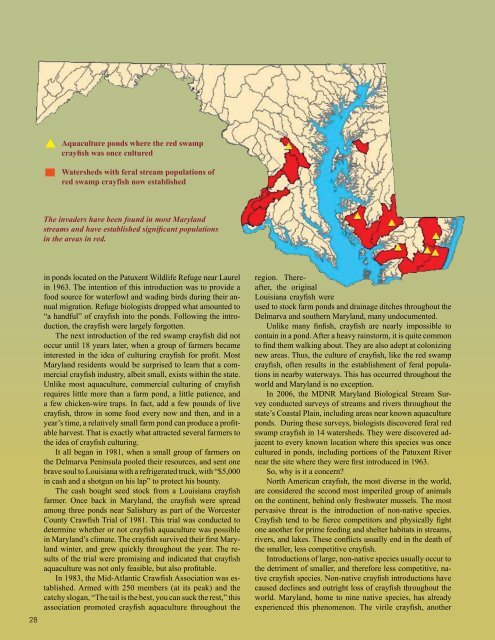Pocomoke Shipbuilding • Vane Brothers - Chesapeake Bay ...
Pocomoke Shipbuilding • Vane Brothers - Chesapeake Bay ...
Pocomoke Shipbuilding • Vane Brothers - Chesapeake Bay ...
You also want an ePaper? Increase the reach of your titles
YUMPU automatically turns print PDFs into web optimized ePapers that Google loves.
28<br />
▲ Aquaculture ponds where the red swamp<br />
crayfish was once cultured<br />
▀<br />
Watersheds with feral stream populations of<br />
red swamp crayfish now established<br />
The invaders have been found in most Maryland<br />
streams and have established significant populations<br />
in the areas in red.<br />
in ponds located on the Patuxent Wildlife Refuge near Laurel<br />
in 1963. The intention of this introduction was to provide a<br />
food source for waterfowl and wading birds during their annual<br />
migration. Refuge biologists dropped what amounted to<br />
“a handful” of crayfish into the ponds. Following the introduction,<br />
the crayfish were largely forgotten.<br />
The next introduction of the red swamp crayfish did not<br />
occur until 18 years later, when a group of farmers became<br />
interested in the idea of culturing crayfish for profit. Most<br />
Maryland residents would be surprised to learn that a commercial<br />
crayfish industry, albeit small, exists within the state.<br />
Unlike most aquaculture, commercial culturing of crayfish<br />
requires little more than a farm pond, a little patience, and<br />
a few chicken-wire traps. In fact, add a few pounds of live<br />
crayfish, throw in some food every now and then, and in a<br />
year’s time, a relatively small farm pond can produce a profitable<br />
harvest. That is exactly what attracted several farmers to<br />
the idea of crayfish culturing.<br />
It all began in 1981, when a small group of farmers on<br />
the Delmarva Peninsula pooled their resources, and sent one<br />
brave soul to Louisiana with a refrigerated truck, with “$5,000<br />
in cash and a shotgun on his lap” to protect his bounty.<br />
The cash bought seed stock from a Louisiana crayfish<br />
farmer. Once back in Maryland, the crayfish were spread<br />
among three ponds near Salisbury as part of the Worcester<br />
County Crawfish Trial of 1981. This trial was conducted to<br />
determine whether or not crayfish aquaculture was possible<br />
in Maryland’s climate. The crayfish survived their first Maryland<br />
winter, and grew quickly throughout the year. The results<br />
of the trial were promising and indicated that crayfish<br />
aquaculture was not only feasible, but also profitable.<br />
In 1983, the Mid-Atlantic Crawfish Association was established.<br />
Armed with 250 members (at its peak) and the<br />
catchy slogan, “The tail is the best, you can suck the rest,” this<br />
association promoted crayfish aquaculture throughout the<br />
region. Thereafter,<br />
the original<br />
Louisiana crayfish were<br />
used to stock farm ponds and drainage ditches throughout the<br />
Delmarva and southern Maryland, many undocumented.<br />
Unlike many finfish, crayfish are nearly impossible to<br />
contain in a pond. After a heavy rainstorm, it is quite common<br />
to find them walking about. They are also adept at colonizing<br />
new areas. Thus, the culture of crayfish, like the red swamp<br />
crayfish, often results in the establishment of feral populations<br />
in nearby waterways. This has occurred throughout the<br />
world and Maryland is no exception.<br />
In 2006, the MDNR Maryland Biological Stream Survey<br />
conducted surveys of streams and rivers throughout the<br />
state’s Coastal Plain, including areas near known aquaculture<br />
ponds. During these surveys, biologists discovered feral red<br />
swamp crayfish in 14 watersheds. They were discovered adjacent<br />
to every known location where this species was once<br />
cultured in ponds, including portions of the Patuxent River<br />
near the site where they were first introduced in 1963.<br />
So, why is it a concern?<br />
North American crayfish, the most diverse in the world,<br />
are considered the second most imperiled group of animals<br />
on the continent, behind only freshwater mussels. The most<br />
pervasive threat is the introduction of non-native species.<br />
Crayfish tend to be fierce competitors and physically fight<br />
one another for prime feeding and shelter habitats in streams,<br />
rivers, and lakes. These conflicts usually end in the death of<br />
the smaller, less competitive crayfish.<br />
Introductions of large, non-native species usually occur to<br />
the detriment of smaller, and therefore less competitive, native<br />
crayfish species. Non-native crayfish introductions have<br />
caused declines and outright loss of crayfish throughout the<br />
world. Maryland, home to nine native species, has already<br />
experienced this phenomenon. The virile crayfish, another

















